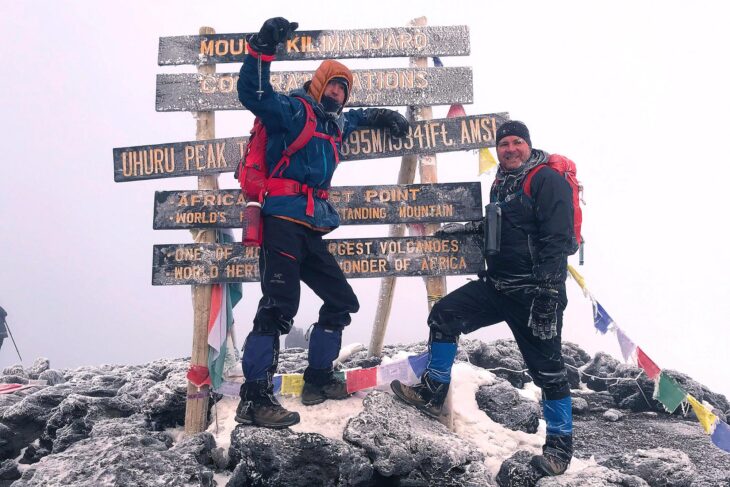
Kilimanjaro Climb
Kilimanjaro is a 5895m (19,341 ft) volcanic mountain, the highest peak of Africa, and the highest freestanding mountain in the world. To get to its summit doesn’t require any technical knowledge as it is mostly a hike. However, the extreme high altitude without supplementary oxygen makes it a serious 6 to 8-day expedition, and things can go wrong very quickly. Thanks to some commercial brochures and tourist guides, many people are made to believe that summiting Kilimanjaro is just a challenging adventure to spice up their African vacations. Unfortunately, such misguiding “sweet talk” can result in tragedies such as a death of a climber near the top of the mountain about 20 hours before we went through. It is estimated that about seven people die on Kili each year. I have no doubt that one of the “hidden” reasons that makes this undertaking all the more dangerous is the rapidity with which one is expected to reach the summit. If the “standard” guidelines for acclimatization schedules to ascend high altitude mountains were applied on Kilimanjaro, people would take 12-14 days to reach the summit.

On the day of our summit bid (6th day on the mountain), we started before midnight at an altitude of 4700m. There was a full moon, and a total lunar eclipse on the North American continent. With the clouds below us and an amazing night sky full of stars, we started our 6-hour, 6-kilometre, and 1200-vertical meter climb. At that altitude, a forward and upward movement becomes very slow and labored. When you stop to drink some water, those 10 seconds of drinking and not breathing will put you in such oxygen deficit that you feel like you have just finished running up a flight of stairs. For five long hours we climbed through a few dry avalanche chutes on a well-traveled zigzag path. At about 5700m, we reached Gilman’s Point, which did not end our pain, but which at least represented the end of the most demanding crux of the whole endeavor. It was about 5 a.m., and while slightly cold, we were happy to have reached this significant point. The weather was nearly perfect; I guessed the temperature was around -5C and most importantly, there was hardly any wind.

The route from Gilman’s Point was significantly easier regardless of the fact we had just then entered the extreme altitude zone. The oxygen levels at 5700m drop to about one half of the amount at sea level. The remaining 2 kilometers to the true summit of Kilimanjaro, the Uhuru Peak, were basically an interesting but rather cold ridge walk. The first section was a narrow path in the snow with some exposure to the right. Making a mistake and losing the footing at the wrong moment could have been potentially fatal. After passing this tight spot, the remainder of our journey was literally a “highway” to the top. We passed Stella Point (elev. 5750m), the place where the tragic accident had taken place a day earlier, and then at last, we were on the top. The wind was blowing on the ridge, I estimated a wind chill of about -15C, and we were happy to see the daybreak with the sun rising in the fog.

I have to admit that even though I had no problems to reach the summit (I felt good, fit, and healthy all the way), I felt the effects of the altitude. As a matter of fact, when we were slowly trudging along the ridge, I felt light headed and wobbly. In order to make sure that I wasn’t “losing it”, I started to give myself simple mathematical problems to see if I could still do the calculations in my head. I now fully understand how easy it is for a high-altitude mountaineer to fall asleep while monotonously moving one leg ahead of the other for hours, or even worse, how it happens that somebody can walk off a cliff without even realizing it. It is a truly delirious state a person finds himself in high up there, and I must say, I am glad I was able to experience a tiny taste of it. When we trekked to the basecamp of Mount Everest (elev. 5364m) three years ago, we reached our maximum altitude of the trip on the Kala Patthar summit (elev. 5644m), and quite frankly, the whole trip was much easier than Kilimanjaro.
Our big thank you goes to our amazing team which made our climb not only a successful and safe trip but also an unforgettable experience with a lot of camaraderie and fun. Chief Kilimanjaro Guide: Faraja Clement Mwaijande Assistant Guide: Julies Mollel Cook: Leopard Amon Senior Porters: Abdala Mbega & Laurent Raphael Toilet Porter: Peterson Kimaro Crew: Pendael Samuel, Bizzu Ramadhan, Hassan Jumanne, Shaban Rajabu, Manase Mzava & Joseph Mgina













